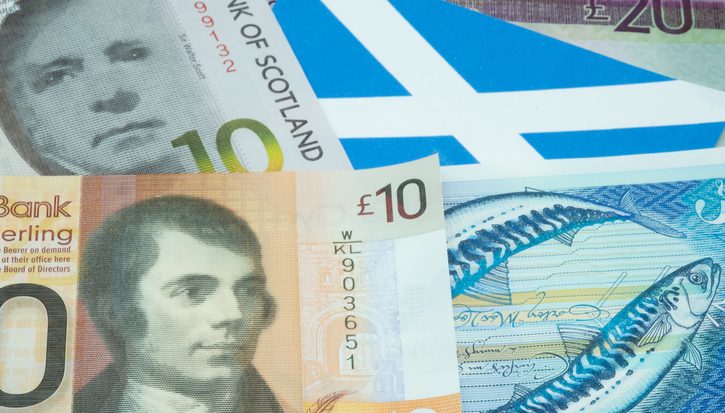A progressive future for income tax? The effects of cutting income tax for higher earners in Scotland
Article
The Scottish Government begins the budget process for Scotland on the 12th December, publishing its draft budget for 2019/20. This will see the Scottish Government set out its plans for devolved taxes and spending in devolved policy areas for the coming year. The draft Budget will face parliamentary scrutiny over the coming months before being finalised, potentially with amendments, before the end of February. Given the make-up of the Scottish Parliament, and the minority SNP Government, the Scottish Government will need one or more opposition parties to back their plans. This briefing focuses on some of the implications of the UK Government’s income tax decisions for the Scottish government, and, in particular, the UK government’s decision to cut taxes for higher earners in the rest of the UK (rUK).
Scotland’s devolved income tax
Following the devolution of further income tax powers to Scotland in 2016 the Scottish government now has power to set income tax rates and thresholds for income tax in Scotland on earnings above the personal allowance (which is reserved to the UK government). The Scottish government used these powers, firstly in 2017/18 to hold the higher rate tax threshold (the point at which higher earners begin to pay the higher rate of income tax) lower than in rUK. While not a tax increase in cash- or real-terms, this meant higher earners in Scotland did not receive a tax cut that higher earners in the rUK did. For 2018/19, in last year’s budget, the Scottish government made more significant changes to the devolved income tax system in Scotland. This saw the introduction of two new income tax bands, and increase in tax rates for higher and additional rate tax payers. Overall this saw reductions in income tax for lower earners and increases in taxes for higher earners in Scotland. This means Scotland now has a very different income tax structure to the rest of the UK (rUK).
Choices for 2019/20
For 2018/19, Scotland’s higher rate tax threshold stands at £43,430, compared to the rUK threshold of £46,000. At last month’s UK budget, the Chancellor announced the higher rate income tax threshold in rUK is set to rise to £50,000 from April 2019. This constitutes a further tax cut for higher earners in rUK– and takes an opposite direction to the Scottish government’s income tax choices so far. Ahead of the publication of the Scottish government’s draft Budget, there is a clear choice before the Scottish government in relation to how to respond to an increasing differential in the income tax paid by higher earners in rUK against that paid by higher earners in Scotland.
The Scottish government remains publicly committed to a progressive income tax agenda. Scotland’s Finance Secretary Dereck Mackay has promised to take “a more progressive approach” to income tax than UK Chancellor Philip Hammond in Scotland’s 2019-20 budget.[1] One of the key decisions facing the Scottish Government for this coming year is how much income higher earners can make before higher-rate tax rates kick in.
How much would it cost to match the UK government tax cut for higher earners?
Table 1 below shows the baseline assumption for Scotland’s higher rate tax threshold[2] uprated with inflation as against the new plans for rUK taxpayers announced by the UK government in the Autumn Budget 2018.
Table 1 – Higher-rate tax threshold projections
Scotland higher rate tax threshold | rUK higher rate tax threshold | |
2019-20 | £44,840 | £50,000 |
2020-21 | £45,470 | £50,000 |
2021-22 | £46,390 | £51,015 |
2022-23 | £47,370 | £52,095 |
Source – IPPR Scotland calculations uprating the Scotland higher rate tax threshold with inflation (using OBR Sep inflation forecasts) against stated UK Government policy for the rUK higher rate tax threshold.
We then used the IPPR Scotland microsimulation tax-benefit model to model the costs and impact of a decision to match the UK government’s £50,000 higher-rate tax threshold in Scotland, and to increase it in line with rUK. The differential is costed from the coming tax year through to the end of the next Scottish Government spending review (2022-23).
Table 2 - Effect on devolved tax revenue of Scottish government applying rUK higher-rate tax threshold change in Scotland (real-terms, 2018/19 prices)
Static revenue change (not including behavioural response) | Dynamic revenue change (including behavioural response) | |
2019-20 | -£310m | -£280m |
2020-21 | -£280m | -£260m |
2021-22 | -£290m | -£260m |
2022-23 | -£290m | -£260m |
Total | -£1160m | -£1060m |
Source: IPPR Scotland tax-benefit model. Static numbers have been adjusted to factor-out dividend income given this is not devolved to Scotland. Adjustments are made on the basis of UK-wide income tax revenues from dividends income.
Note: Behavioural effects are particularly uncertain. Our dynamic numbers have been adjusted for forecast behaviour change, using Scottish Fiscal Commission assumptions and should be treated cautiously.
Numbers have been rounded to the nearest 10 million so columns may not sum.
The Personal Allowance is reserved and so applies across the UK.
All options modelled account for the increase of the personal allowance threshold scheduled from 2019/20 for the UK as a whole as this power is reserved to UK government.
Implications
Our analysis shows that the costs of matching in Scotland the UK government’s decision to cut taxes for higher earners in rUK could be significant, at a cost of £280m in 2019/20, and £1.06bn in real terms (2018/19 prices)[3] between 2019/20 and 2022/23 (the last year of the forthcoming spending review).
This could have a significant impact on public spending in Scotland, particularly if the costs for this tax cut were to be found in reductions in spending among non-protected departments (those outside of health, police and social security). A reduction in spending for non-protected departments worth £280m, would amount to a reduction in spending of 2.0% in non-protected departments in Scotland[4].
If the Scottish government, and Scottish parliament more widely, wish to end public spending cuts, then far from being able to afford tax cuts, the Scottish government may need to consider tax rises in 2019/20 and across the spending review period to 2022/23. Particularly, if the Scottish government and Scottish parliament wish to repair the damage done to public services in Scotland through the last decade of spending cuts, and make progress towards its ambitious policy priorities around, for example, reducing child poverty, narrowing the attainment gap and fair access gap, and delivering a stronger and more inclusive economy.
Acknowledgements
The content and opinions expressed in this research are those of the author alone. This marks the first in an analysis series looking at the Scottish government draft budget. IPPR Scotland would like to thank STUC for their financial support in making this series possible.
[1] Real terms figures are all based on 2018/19 prices using Budget 2018 GDP deflators at market prices https://www.gov.uk/government/statistics/gdp-deflators-at-market-prices-and-money-gdp-october-2018-budget-2018
[2] The Scottish Government draft Budget for 2018/19 outlined that the total Fiscal Resource Budget Limit for 2018/19 was £26.860bn and that (RDEL) protected spending for the NHS, Police and Social Security was £14.040bn, leaving £12.820bn of non-protected spending in 2018/19.
[3] https://www.bbc.co.uk/news/live/uk-scotland-scotland-politics-46018410
[4] The Higher Rate Tax Threshold is the level of earnings over which tax payers pay the ‘higher rate’ of income tax. The ‘higher rate’ is set at 40% in rUK and 41% in Scotland.
Related items

Prophet, spoiler, or free rider?: The United States and climate change
Global climate action sits firmly in the crosshairs of the Trump administration.
Resilient by design: Building secure clean energy supply chains
The UK must become more resilient to succeed in a more turbulent world.
Policy credibility and the Scottish Budget